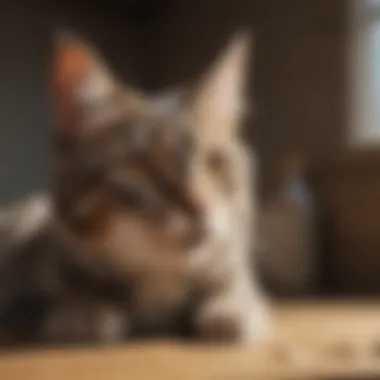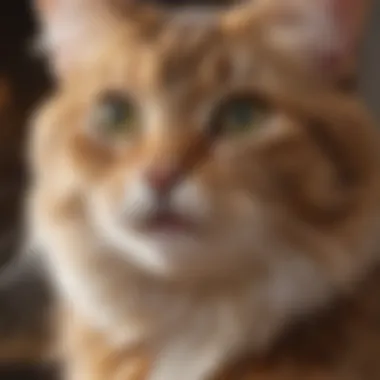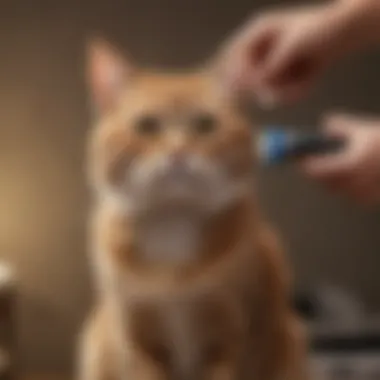Choosing the Best Brush for Short-Haired Cats


Intro
Grooming a cat is essential for both the pet's health and the owner's satisfaction. Short-haired cats have distinct grooming requirements that differ from their long-haired counterparts. Selecting the right brush is fundamental not only for maintaining a healthy coat but also for enhancing the bond between the owner and their feline companion.
In this guide, we will explore the various factors that influence the choice of brush for short-haired cats. We will assess the types of brushes available, their specific features, and how they relate to the grooming needs of different breeds. By understanding these elements, pet owners can make informed decisions that benefit both themselves and their cats.
Animal Species Profile
Prelude to the animal species
Cats, scientifically known as Felis catus, have been companions to humans for thousands of years. They are cherished for their independent nature and unique personalities. Among domestic cats, there are distinct categories including short-haired and long-haired breeds. Short-haired cats have specific grooming needs.
Understanding Short-Haired Cat Breeds
Knowing the specific characteristics and grooming needs of short-haired cats is essential when selecting the right brushing tool for them. This section provides a comprehensive look at these factors, ensuring that cat owners can make informed decisions. By understanding their pet's unique traits, you can enhance their grooming experience and promote optimal health.
Characteristics of Short-Haired Cats
Short-haired cats have a range of physical attributes that define their breed standards. Their fur is typically sleek and lies flat against the skin. Common breeds like the American Shorthair, British Shorthair, and Russian Blue exhibit various patterns and colors, but they share similar grooming requirements.
These cats generally have less dense fur compared to long-haired counterparts. The short coat allows the cat to maintain temperature without becoming overly hot or cold. However, this does not mean that they require no grooming. Regular maintenance is crucial to prevent matting and skin issues.
In addition to fur characteristics, short-haired cats often have unique grooming behaviors. They may groom themselves frequently, helping to untangle and clean their fur. However, even with this self-grooming, owners need to assist them in managing loose hair and maintaining coat health.
Grooming Needs of Short-Haired Cats
Short-haired cats still benefit significantly from regular grooming, despite their low-maintenance fur. The primary goals of grooming include removing loose hair, dirt, and debris while promoting healthy skin and coat. Additionally, grooming helps minimize shedding in the home environment.
Some key grooming tasks to consider are:
- Brushing: It removes loose hair and prevents it from spreading around the house. Regular brushing can cut down on your cat's shedding.
- Bathing: While not always necessary, occasional baths can help maintain coat cleanliness, especially if your cat has gotten into something dirty.
- Nail clipping: Keeping nails trimmed is essential not only for comfort but also to prevent injury to both the cat and its owners.
To meet these grooming needs effectively, choosing the right brush based on the cat's coat type is vital. Each brush type offers different benefits and caters to specific requirements, which we will discuss further in the next sections.
Regular grooming enhances your cat's comfort and reduces both shedding and hairballs.
Understanding these grooming needs allows cat owners to foster a healthier environment for their feline companions and ensures that their grooming experiences are as positive and rewarding as possible.
The Importance of Regular Grooming
Regular grooming plays a crucial role in maintaining the health and well-being of short-haired cats. While they tend to require less grooming than long-haired breeds, establishing a routine can significantly benefit both the cat and the owner. Understanding this importance can enhance the grooming experience and lead to a more harmonious relationship.
One key reason for regular grooming is that it promotes healthy skin and coat. Cats produce natural oils that help maintain the condition of their fur. Without regular grooming, these oils cannot be evenly distributed. As a result, the coat can become dry or matted, leading to potential skin issues. Furthermore, grooming serves to remove dirt, debris, and loose fur, preventing potential irritations to the cat's skin.
Another important factor is that grooming can reduce stress levels in cats. Many cats appreciate being brushed and can find it soothing. This not only allows them to relax but also strengthens the bond between the cat and its owner. Hence, establishing a positive grooming routine can lead to a deeper trust.
Regular grooming is not just about aesthetics; it is about health and emotional well-being.
Benefits for Skin and Coat Health


The health of a cat's skin and coat is significantly influenced by consistent grooming. Short-haired cats, though less prone to mats and tangles, can still experience build-up of dead hair and skin cells. This build-up can lead to skin conditions such as dermatitis or infections. Regular brushing helps to address this by effectively removing these substances, leading to healthier skin.
Moreover, grooming facilitates the distribution of those essential natural oils mentioned earlier. These oils not only provide moisture but also impart a natural shine to the cat's coat. Owners often notice that their cat's fur looks sleek and shiny after consistent grooming sessions.
Additionally, the act of grooming serves as an opportunity to inspect the cat's skin for any unusual signs, such as bumps or parasites. Such observations can be vital for early detection of underlying health issues, allowing for timely veterinary intervention.
Reduction of Shedding and Hairballs
Short-haired cats are known for shedding, and without regular grooming, loose fur can accumulate around the home. Regular brushing minimizes this shedding and keeps the living space cleaner. Furthermore, it helps to control the amount of fur that ends up in the cat's stomach.
Hairballs are a common concern for cat owners. When cats groom themselves, they ingest loose fur, which can result in hairballs. Regular brushing can significantly reduce the amount of hair that is ingested during self-grooming, thus decreasing the occurrence of these unpleasant regurgitations.
In summary, the practice of regular grooming is essential for short-haired cats. It enhances their skin and coat health while also reducing shedding and hairballs. By committing to a grooming routine, cat owners foster a healthier and happier environment for their feline companions.
Types of Brushes for Short-Haired Cats
Choosing the right type of brush for short-haired cats is essential. This decision impacts not only the cat’s comfort but also the quality of grooming. The right brush can make grooming smooth, enhance coat health, and even strengthen the bond between you and your feline. Cat owners must consider the unique features and benefits of various brushes that cater specifically to short-haired breeds.
Slicker Brushes
Slicker brushes are designed with fine bristles that are closely spaced together. This design allows them to effectively remove loose fur while also addressing dirt and dander. For short-haired cats, a slicker brush may help in reducing shedding and preventing hairballs. These brushes can penetrate the coat and reach the undercoat, promoting better skin health. When using slicker brushes, it is crucial to be gentle to avoid irritating the skin.
Bristle Brushes
Bristle brushes come with softer bristles compared to slickers. This makes them ideal for short-haired cats. They are effective for removing loose hair and distributing natural oils throughout the coat, giving it a healthier shine. Bristle brushes can be a perfect choice for cats that get anxious or dislike intense grooming. They are especially useful during regular grooming sessions to maintain coat health without causing stress.
Rubber and Massage Brushes
Rubber brushes serve a dual purpose: they remove loose hair and provide a pleasant massage for the cat. The rubber material can be gentler on the skin. For cats that enjoy physical touch, massage brushes can be quite stimulating. Regular use of these brushes can lead to more relaxed grooming sessions. Owners should remember that these brushes may not remove as much undercoat fur but excel in keeping the top coat in good condition.
Comb Brushes
Comb brushes are versatile and can serve various functions. They often feature both wide and narrow teeth. For short-haired cats, a comb can help in untying knots and removing debris. It is beneficial for checking the cat’s skin for any irritations or parasites. Cats who have short hairs may still develop small tangles, especially in areas like behind the ears or under the legs. Using a comb frequently can help prevent these issues.
Regular grooming with the right brush helps reduce shedding, minimizes hairballs, and encourages bonding.
Key Features to Consider
When selecting a brush for short-haired cats, certain features significantly impact grooming effectiveness. These considerations can enhance the experience for both the owner and the cat, supporting a consistent grooming routine and ensuring the well-being of the pet's coat. Key elements to pay attention to include the bristle material and design, ergonomic handling, and the size and weight of the brush. Each of these factors plays a role in determining how well the brush performs its intended functions, influencing the satisfaction of both the user and the pet.
Bristle Material and Design
Choosing the appropriate bristle material is vital for achieving optimal grooming results. Different materials address unique needs. For example, synthetic bristles offer durability and effective removal of loose fur, while natural bristles can provide a gentle touch.
Furthermore, the design of the bristles affects their functionality. Brushes with tightly packed bristles can penetrate dense fur, whereas those with wider spacing might be better suited for delicate grooming on sensitive areas.
Some brushes offer flexible bristle configurations, which can adjust to the contours of the cat's body, enabling a more thorough grooming process without causing discomfort. Understanding these nuances ensures that the brush selected aligns with the specific grooming needs of the short-haired cat.
Ergonomic Handle for Easy Use
The importance of an ergonomic handle cannot be overstated. Grooming sessions can be lengthy, and an uncomfortable handle can lead to fatigue or poor technique. An ergonomically designed handle provides a comfortable grip, helping to maintain control throughout the grooming process.


Handles that fit well in the hand help prevent slipping, which enhances the ability to maneuver without stressing the cat. Moreover, materials that offer better grip reduce the chances of the brush slipping from the user's hand, ensuring a smooth grooming experience. This ultimately leads to a more positive atmosphere during grooming sessions, fostering trust and relaxation in the cat.
Size and Weight of the Brush
The size and weight of a brush also contribute to its usability. A lightweight brush is easier to handle, reducing fatigue during longer grooming sessions. Additionally, the size should align with the size of the cat. Smaller brushes are often more effective for precise grooming around sensitive areas, while larger brushes might cover larger areas of fur more quickly.
It is also critical to consider the cat's comfort. Brushes that are too large or bulky may be more intimidating and uncomfortable for short-haired cats. A well-chosen size and weight can lead to a more harmonious grooming experience, ensuring the cat remains calm and cooperative. By considering these aspects, pet owners can enhance their grooming routines effectively.
How to Introduce Grooming to Your Cat
Grooming is not just about keeping a cat's coat neat; it plays a vital role in their overall health and well-being. For short-haired cats, regular grooming ensures that their skin and fur remain in excellent condition. This section highlights practical strategies to ease your cat into a grooming routine effectively. It focuses on creating a comfortable environment and employing positive reinforcement, both crucial for establishing a stress-free grooming experience.
Creating a Comfortable Environment
Creating a welcoming atmosphere for grooming is essential. Cats are sensitive creatures, and introducing grooming in a calming way can make a significant difference. Start by choosing a quiet time and space where your cat feels safe. Avoid areas with loud noises or distractions. A cozy room or a favorite blanket can help set the right tone.
Here are some considerations when you prepare the environment:
- Choose a familiar spot: Cats feel more secure in their own space.
- Limit distractions: Ensure there are no loud appliances or sudden movements.
- Use calming scents: Some smells, such as lavender, are known to soothe cats.
Allow your cat to explore the grooming tools. Let them sniff the brush before using it. If they seem curious, gently brush a small section of their coat. This introduction can make them more accepting of full grooming sessions later on.
Using Positive Reinforcement
Positive reinforcement is an effective method to associate grooming with pleasant experiences. Cats respond well to rewards. When you engage in grooming, keep treats close by and praise your cat throughout the process. This approach will help them connect grooming with positive outcomes.
Some tips to utilize positive reinforcement include:
- Offer treats during and after brushing. Choose their favorite snacks to make it more appealing.
- Provide plenty of praise. Speak in soft tones to reassure them.
- Take it slow. If your cat shows signs of distress, pause and give them space. Proceed only once they seem relaxed.
Using these methods consistently can lead your cat to enjoy grooming sessions, reinforcing the behavior and helping them to become more comfortable over time.
Regular grooming fosters a bond between you and your cat. It can also reduce stress for both parties, making the experience enjoyable.
Review of Popular Brushes for Short-Haired Cats
Choosing the right grooming tool goes beyond just aesthetics. It directly influences your cat's comfort and overall coat health. Understanding the review of popular brushes for short-haired cats is essential because it offers a curated selection based on user experiences and effectiveness. With numerous brushes available, evaluating attributes such as quality, price, and ease of use is important for pet owners. A familiarization with the best products will aid in making informed decisions, leading to enhanced grooming experiences for both the cat and owner.
Top-Selling Slicker Brushes
Slicker brushes are a staple in grooming short-haired cats. They feature short, fine wires that effectively remove loose fur and debris. The bristles are designed to reach the undercoat without causing discomfort. Among the most popular options is the FURminator Slicker Brush. Pet owners praise it for its effective hair removal and ease of cleaning. Another notable product is the Pet Neat Pet Grooming Brush, favored for its ergonomic handle and comfort during use.
When selecting a slicker brush, consider:
- Wire firmness – firmer wires can penetrate deeper but might irritate sensitive skin.
- Handle design – look for brushes that reduce hand strain during grooming sessions.
Highly Rated Bristle Brushes
Bristle brushes provide a gentle approach to grooming, making them excellent for short-haired cats that can be sensitive. They are designed to distribute natural oils while removing dirt. The Hertzko Self Cleaning Slicker Brush is highly regarded for its self-cleaning feature, which saves time after grooming. Another excellent option is the PetFusion Brush, which combines natural and synthetic bristles for a thorough groom.
Some considerations to assess when choosing bristle brushes include:


- Bristle material – varying materials can alter effectiveness.
- Size of the brush – select a size that fits comfortably in your hand for ease of use.
Best Rubber and Massage Brushes
Rubber brushes and massage brushes serve dual purposes: cleaning and comforting your cat. They stimulate the skin while gently collecting loose fur, making them ideal for relaxed grooming sessions. The Chirpy Pets Rubber Grooming Brush is a popular choice, appreciated for its ease of use in wet or dry conditions. The Pet Zone Pet Grooming Brush also garners attention for its ability to relieve stress in pets while providing effective grooming.
When considering rubber and massage brushes, pay attention to:
- Comfort – the design should allow you to groom without causing stress to your feline friend.
- Versatility – options that work well in both wet and dry conditions can add value.
In summary, the landscape of brushes for short-haired cats is diverse. Each type has its unique advantages. Understanding these details can help cat owners choose the best grooming tool that enhances the overall grooming experience.
Maintaining Your Brush
Regular maintenance of your grooming brush is essential for both the health of your short-haired cat and the longevity of the brush itself. A well-maintained brush improves grooming efficiency, ensuring a smoother grooming experience. Moreover, it helps in reducing the risk of skin irritations and infections in your cat caused by dirt and bacteria buildup on the brush.
Cleansing your brush not only removes accumulated fur and debris but also maintains the integrity of the bristles. Over time, bristles can become bent or damaged, which may not only compromise their effectiveness but also cause discomfort to your cat during grooming sessions. Thus, establishing a routine for cleaning and caring for your brush is crucial.
Cleaning Techniques
The first step in maintaining your brush is to regularly clean it. Follow these steps for effective cleaning:
- Remove Hair: Start by removing any hair from the brush. You can use your fingers or a comb to gently pull off the clumps of fur.
- Wash with Soap: Prepare a solution of warm water and mild soap. Dip the brush in the solution, and use a soft cloth or sponge to clean the handles and the bristles.
- Rinse Thoroughly: After washing, rinse the brush under running water, ensuring all soap residue is removed. Any leftover soap can irritate your cat’s skin when you groom them.
- Dry Properly: Shake off excess water and lay the brush on a clean towel to dry. Avoid leaving the brush in direct sunlight as it may warp the bristles.
By following these cleaning techniques, you safeguard your cat from potential skin issues while ensuring your brush retains its effectiveness.
Storage Recommendations
Proper storage of your grooming brush is just as important as cleaning. This helps in preserving the shape and functionality of the brush. Here are some recommendations for effective storage:
- Use a Designated Spot: Choose a specific place in your home for your grooming tools. This makes them easy to find when needed.
- Keep Away from Moisture: Store the brush in a dry area to prevent mold or bacteria growth. Moist environments can damage the bristle material over time.
- Avoid Compression: Do not stack heavy items atop your brush. This can cause the bristles to bend, reducing their effectiveness.
- Utilize Cases or Holders: If possible, use a brush holder or a case to protect the bristles and maintain their shape.
Maintaining your brush through cleaning and proper storage enhances its functionality and promotes the well-being of your short-haired cat. An often overlooked aspect, these practices can make a significant difference in your grooming routine.
End
Selecting the right grooming brush for short-haired cats is essential. A suitable brush not only contributes to the overall health of your cat's coat but also makes the grooming experience more pleasant for both the pet and the owner. Regular grooming helps to reduce shedding, minimize hairballs, and maintain skin health, ultimately leading to a happier feline.
In this article, we have examined several vital elements to consider when choosing a brush. Understanding the unique grooming requirements of short-haired cat breeds is crucial. Furthermore, recognizing the different types of brushes available, such as slicker, bristle, rubber, and comb brushes, allows you to make an informed decision that suits your pet's needs.
Investing time in evaluating features like bristle material, brush design, and ergonomics greatly influences ease of use. Not only does it affect your comfort during grooming, but it also impacts how well the brush performs on your cat's coat.
Regular grooming is not merely a chore; it is an opportunity to bond with your pet. Utilizing proper techniques and maintaining the brush properly ensures longevity and efficiency. Thus, understanding both grooming routines and brush maintenance is pivotal in ensuring your cat remains healthy and content.
"A well-groomed cat is a happy cat."
Recap of Key Points
- Short-haired cats have specific grooming needs that differ from long-haired breeds.
- Regular grooming contributes to skin and coat health while reducing shedding.
- Different types of brushes cater to various grooming requirements.
- Consider the brush's materials, design, and ergonomics for effective use.
- Introduce grooming positively to ensure a comfortable experience for your cat.
- Maintain brushes properly for their longevity and effectiveness.
Encouragement for Regular Grooming
Making grooming a regular part of your cat's routine is vital. It greatly enhances their quality of life. Regular grooming not only keeps their coat in top condition but also serves as a form of affection and attention.
Set aside time each week, allowing your cat to become accustomed to the process. Utilize treats or positive reinforcement to create a more enjoyable experience, making the bonding between you and your cat stronger. Remember that your attentive care plays a significant role in your cat's health and happiness.
In summary, embrace grooming as a means of care and connection, rather than a task. The positive effects on your short-haired cat's well-being are considerable and should inspire you to stay consistent.







